COMPOUND MONOCULAR MICROSCOPE
MAKER:ATTRIBUTED TO ANDREW PRITCHARD
MODEL: APLANATIC ENGISCOPE
c. 1840 (1835-45)
UNSIGNED
Text by, and collection of Dr Jurriaan de Groot
Please Click On Any Picture for a Larger Version
DESCRIPTION:
This is an example of a “Pritchard model” microscope, which is unsigned. The presence of the Turrell stage suggests that it dates from after 1834.
The instrument is supported by a tripod foot, the legs being of equal proportions, unlike most examples signed by Pritchard himself, which have an asymmetrical configuration. From this arises a central 110 mm tall brass pillar which extends into a compass joint which can be tightened. Its central portion ends in a clamp which encircles the limb, and can be tightened with a large knurled knob. This allows for rotation of the entire body of the microscope through 90° in both directions for use with a vial holder which can be affixed to a lug with two brass pins in lieu of the stage.
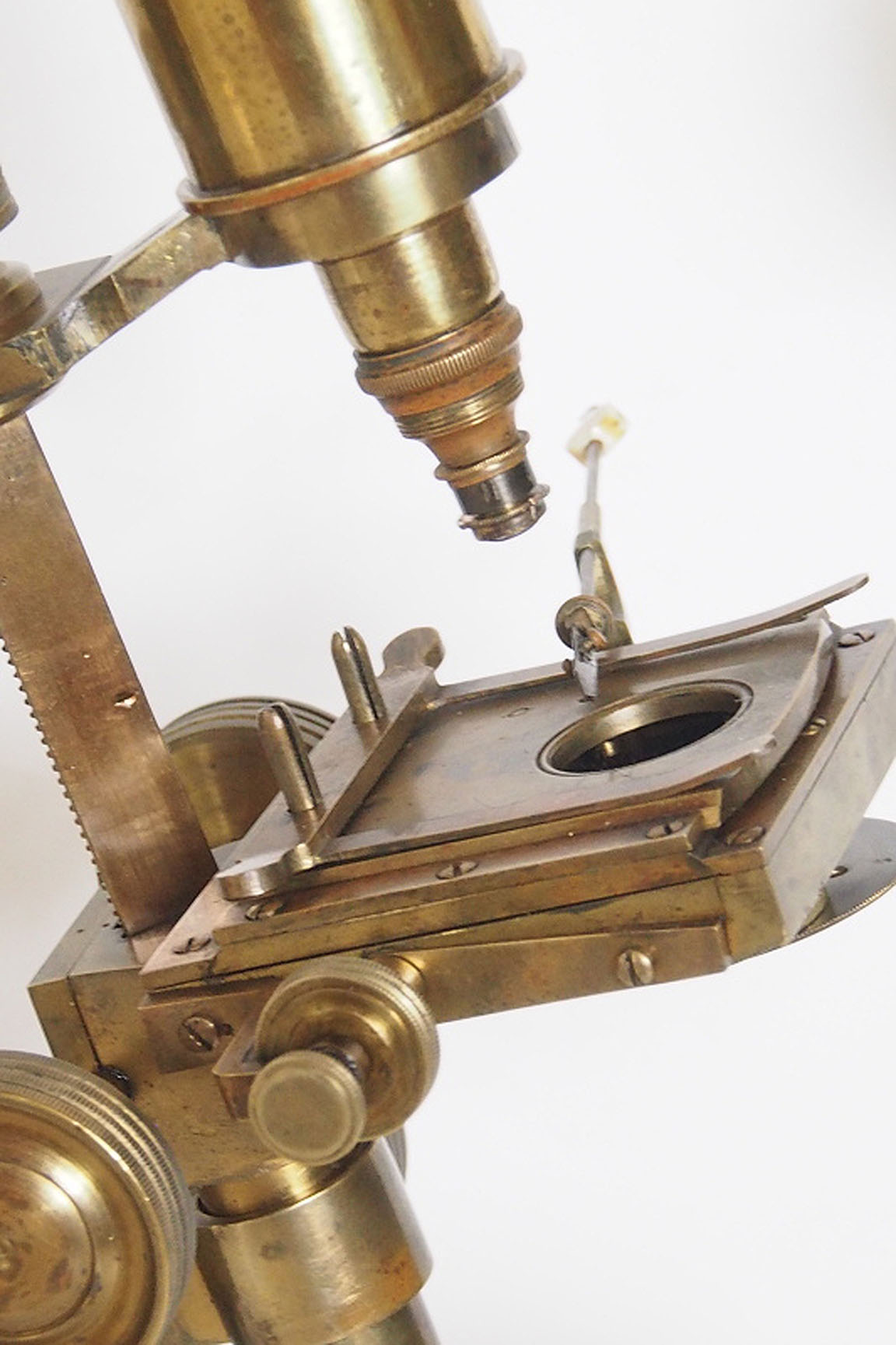 The classical Turrell stage is of the type first described, and features U-shaped sliding stage clips and concentric controls for the X and Y axis stage movements. Attached to its under surface is a cylindrical screw-in attachment with a wheel of aperture stops.
The classical Turrell stage is of the type first described, and features U-shaped sliding stage clips and concentric controls for the X and Y axis stage movements. Attached to its under surface is a cylindrical screw-in attachment with a wheel of aperture stops.
The tailpiece is an extension of the limb and carries a sleeve for the single-sided concave mirror. The upper end of the limb contains a triangular bar with rack and pinion coarse adjustment which is operated by two knurled heads. There is no fine adjustment. The horizontal arm is double sided but on this example, unlike some signed Pritchard examples, there is no provision for use as a simple microscope. Instead, a single threaded aperture takes the 185 mm long body tube with an internal diameter of 33.2 mm for the eye piece.
ACCESSORIES:
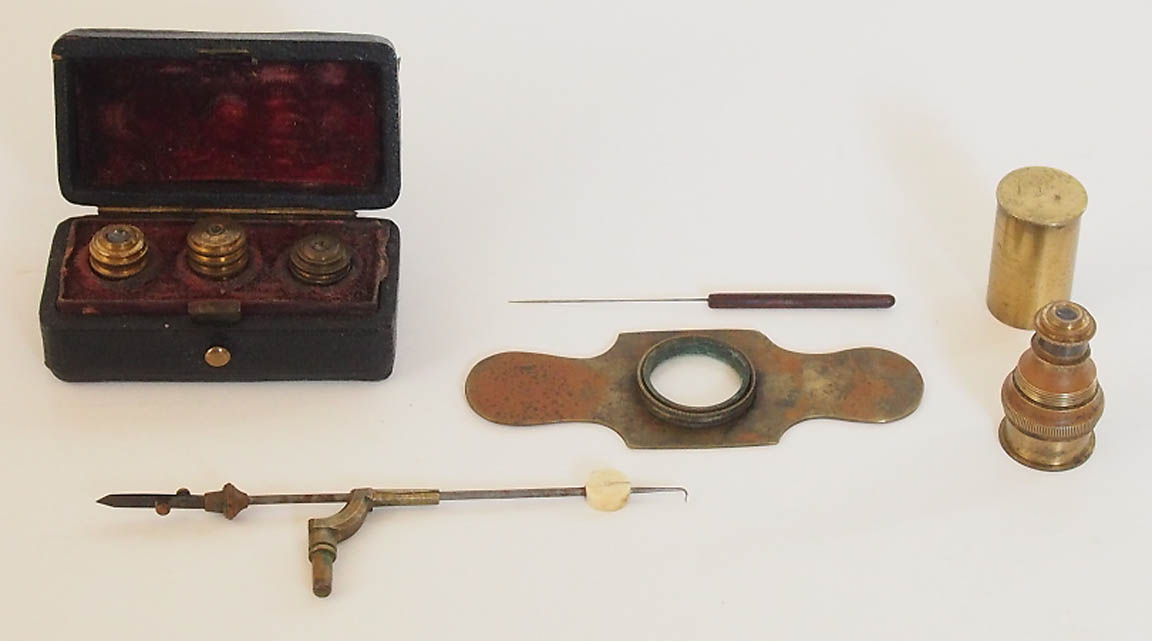
EYEPIECES:
There is a single top hat eye piece with an approximate magnification of x5.
OBJECTIVES:
When acquired, this microscope came with a single objective with protective screwcaps and Pritchard pre-RMS thread, with an approximate focal length of ½ inch. The present owner has added a set of Chevalier-type French button objectives contained in a morocco covered box lined with dark red velvet, which have the same female thread.
Optical data for these obtained with stage micrometre and Cheshire apertometer:
| Objective |
n.a. | Magnification
with eyepiece |
|---|
| 1/2 In | 0.17 | 85 |
| No 3 | 0.38 | 180 |
| Unmarked | 0.40 | 270 |
| No 5 | 0.56 | 290 |
STAGE ACCESSORIES:
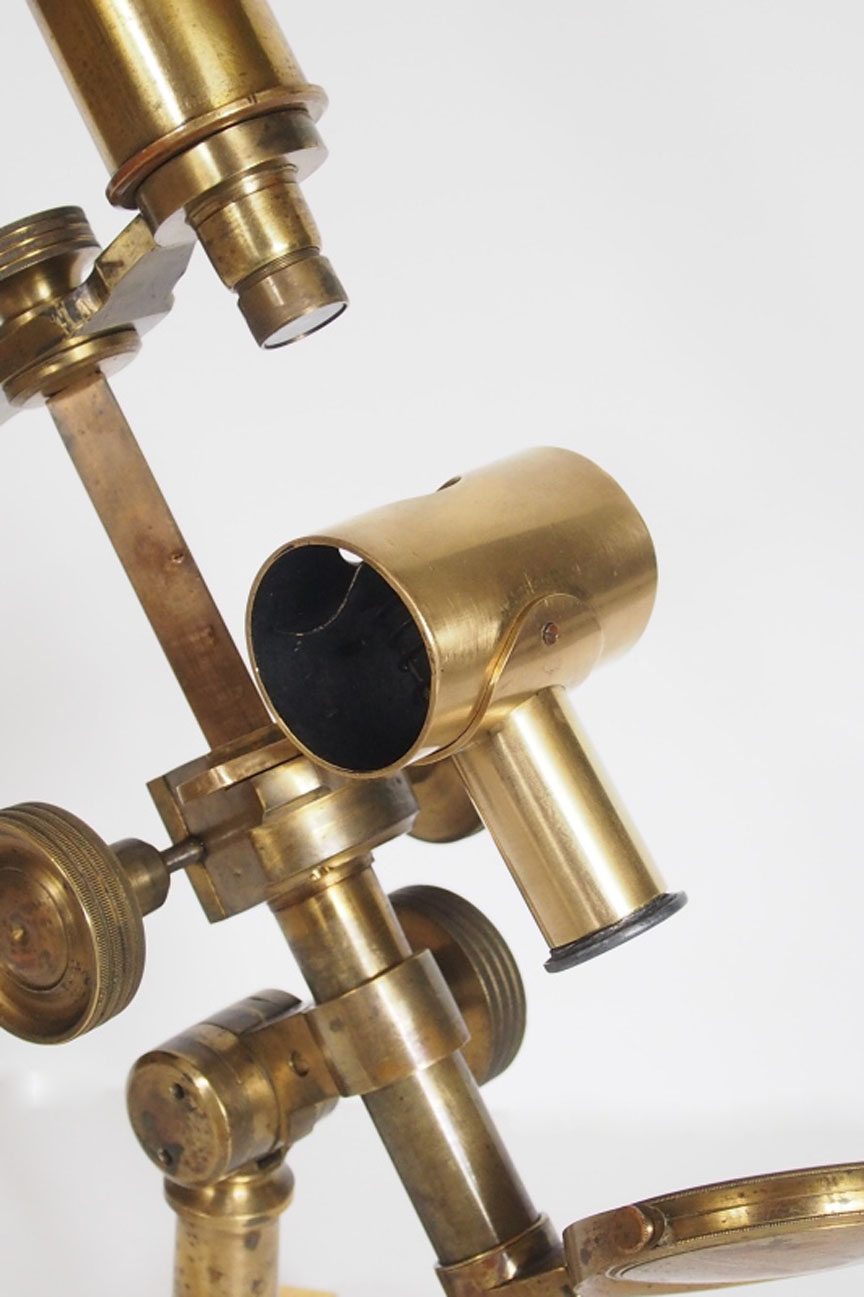 These include stage forceps, a Pritchard-type live box, and a bulls eye condenser on a stand. Shown on the microscope to the left is a replica vial holder created by the present owner.
These include stage forceps, a Pritchard-type live box, and a bulls eye condenser on a stand. Shown on the microscope to the left is a replica vial holder created by the present owner.
CASE:
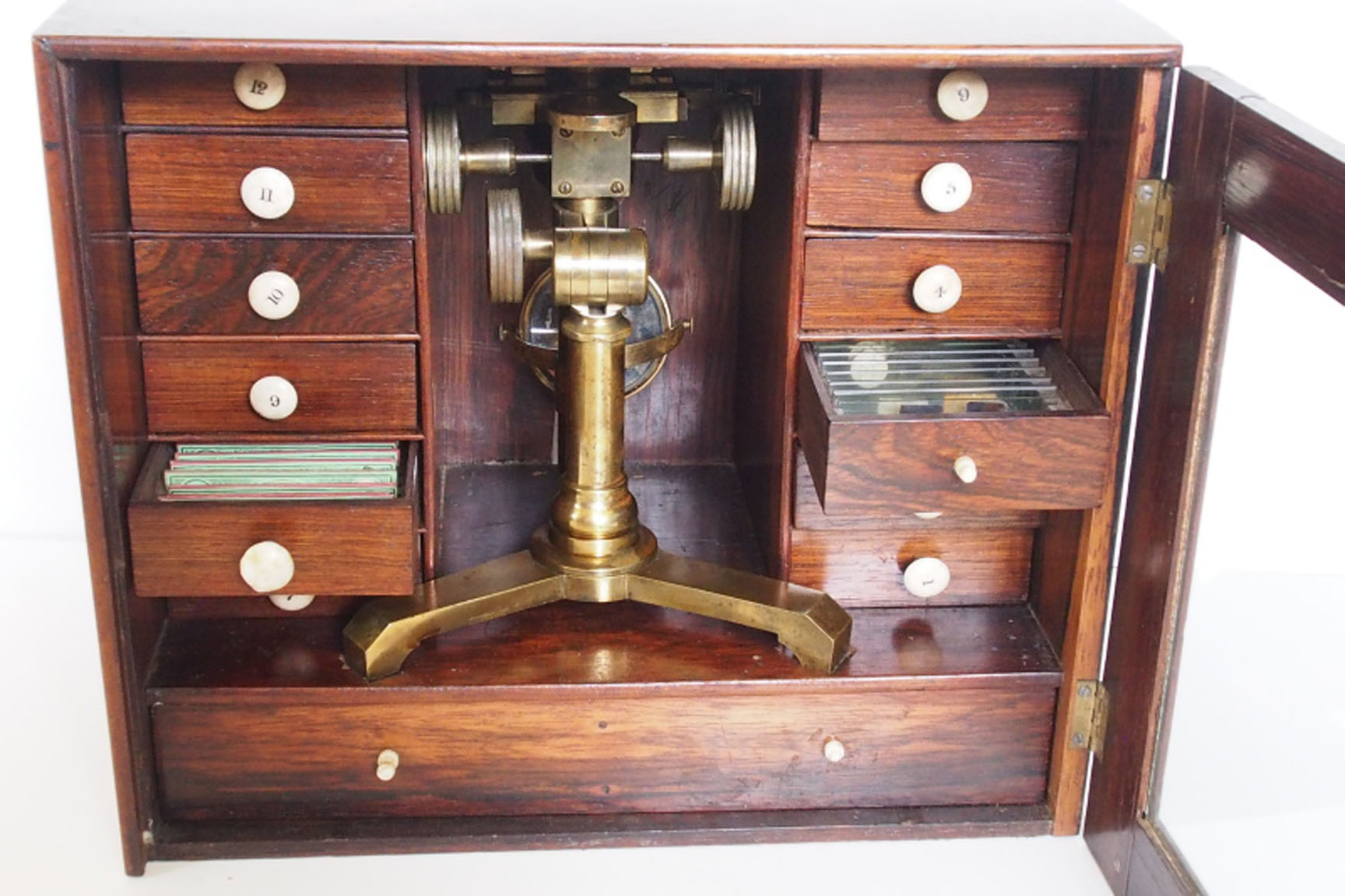 The microscope is stored in its original attractive rosewood cabinet measuring 280 mm (H)x 325 mm (W)x 203 mm (D) with glass panelled front door. The body tube and all accessories are stored in a large bottom drawer. The microscope body slides into a central recess flanked by a row of 6 drawers on each side which have turned and numbered bone knobs. These contain a selection of standard 1 x 3 inch slides, many retailed by J. Wellington of Cheltenham.
The microscope is stored in its original attractive rosewood cabinet measuring 280 mm (H)x 325 mm (W)x 203 mm (D) with glass panelled front door. The body tube and all accessories are stored in a large bottom drawer. The microscope body slides into a central recess flanked by a row of 6 drawers on each side which have turned and numbered bone knobs. These contain a selection of standard 1 x 3 inch slides, many retailed by J. Wellington of Cheltenham.
HISTORY OF THIS INSTRUMENT:
Like many, if not most, Pritchard type microscopes including those signed by himself, this microscope was probably made by an instrument maker for the trade. It is known that Hugh Powell, Andrew Ross, and James Smith at an earlier stage in their careers made microscopes for Pritchard, while undoubtedly, there were also others, now unknown.
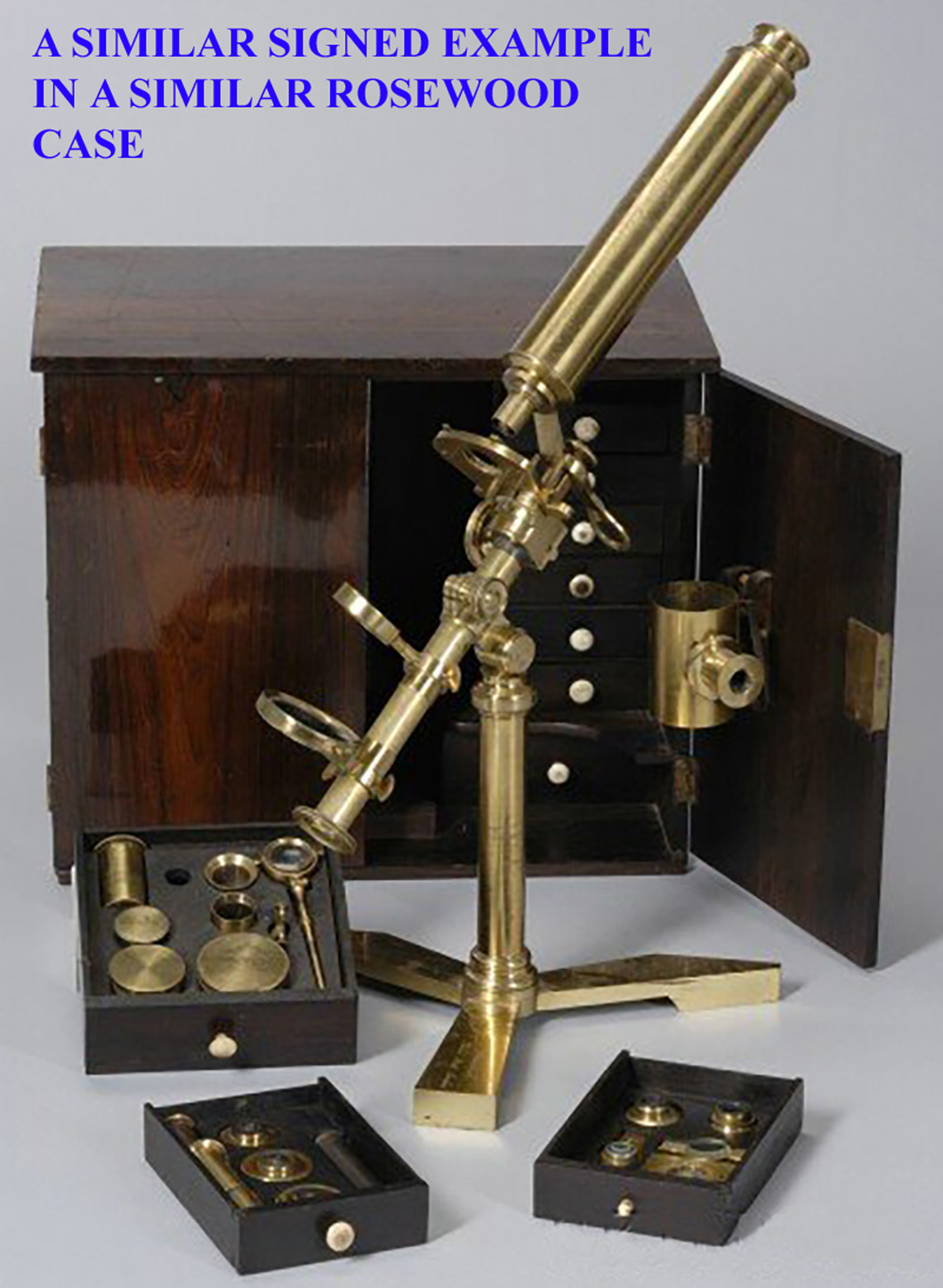 Other identical examples of this microscopes are known to exist, while the rosewood cabinet shows a great resemblance to another which houses a more elaborate microscope set signed by Andrew Pritchard when trading from his 263 Strand address (see illustration shown to the left).
Other identical examples of this microscopes are known to exist, while the rosewood cabinet shows a great resemblance to another which houses a more elaborate microscope set signed by Andrew Pritchard when trading from his 263 Strand address (see illustration shown to the left).
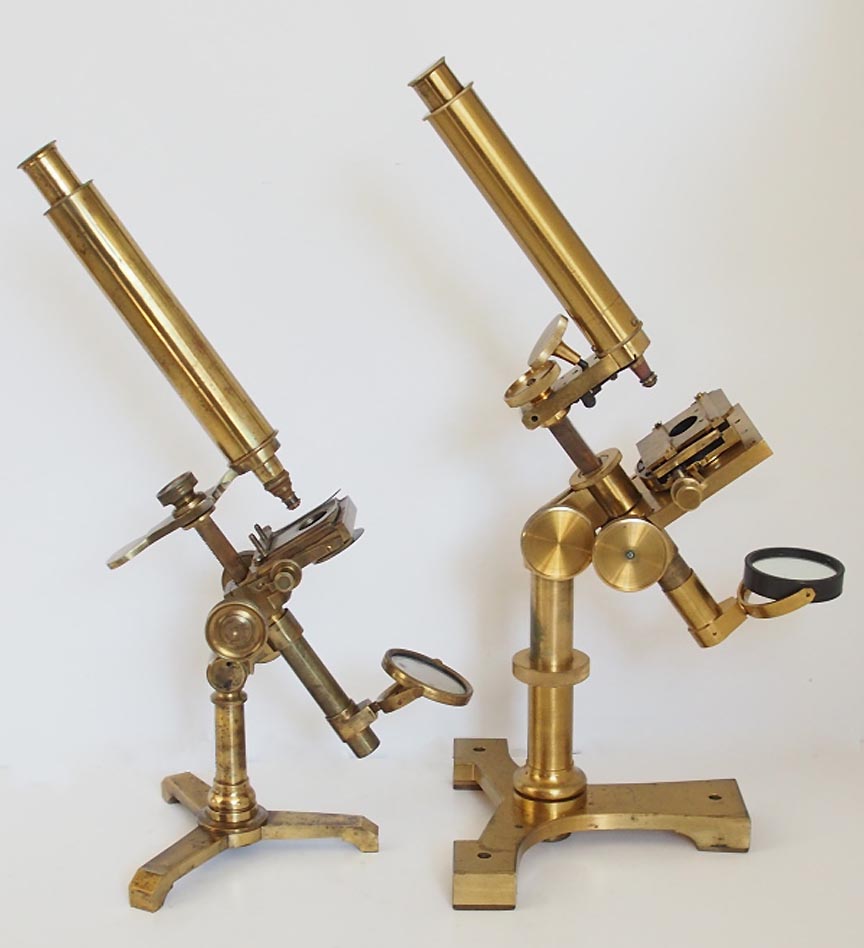 For a more detailed history of Andrew Pritchard and his microscopes see the page on Andrew Pritchard’s
For a more detailed history of Andrew Pritchard and his microscopes see the page on Andrew Pritchard’s Massive
model elsewhere on this site. Shown here to the right are the smaller Pritchard microscope featured at the top of this page, next to his massive stand. Clicking on the image will link to more images comparing the two.
 The classical Turrell stage is of the type first described, and features U-shaped sliding stage clips and concentric controls for the X and Y axis stage movements. Attached to its under surface is a cylindrical screw-in attachment with a wheel of aperture stops.
The classical Turrell stage is of the type first described, and features U-shaped sliding stage clips and concentric controls for the X and Y axis stage movements. Attached to its under surface is a cylindrical screw-in attachment with a wheel of aperture stops. 
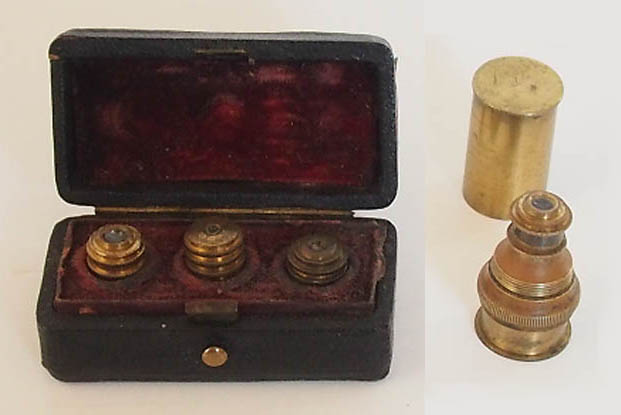
 These include stage forceps, a Pritchard-type live box, and a bulls eye condenser on a stand. Shown on the microscope to the left is a replica vial holder created by the present owner.
These include stage forceps, a Pritchard-type live box, and a bulls eye condenser on a stand. Shown on the microscope to the left is a replica vial holder created by the present owner. The microscope is stored in its original attractive rosewood cabinet measuring 280 mm (H)x 325 mm (W)x 203 mm (D) with glass panelled front door. The body tube and all accessories are stored in a large bottom drawer. The microscope body slides into a central recess flanked by a row of 6 drawers on each side which have turned and numbered bone knobs. These contain a selection of standard 1 x 3 inch slides, many retailed by J. Wellington of Cheltenham.
The microscope is stored in its original attractive rosewood cabinet measuring 280 mm (H)x 325 mm (W)x 203 mm (D) with glass panelled front door. The body tube and all accessories are stored in a large bottom drawer. The microscope body slides into a central recess flanked by a row of 6 drawers on each side which have turned and numbered bone knobs. These contain a selection of standard 1 x 3 inch slides, many retailed by J. Wellington of Cheltenham. Other identical examples of this microscopes are known to exist, while the rosewood cabinet shows a great resemblance to another which houses a more elaborate microscope set signed by Andrew Pritchard when trading from his 263 Strand address (see illustration shown to the left).
Other identical examples of this microscopes are known to exist, while the rosewood cabinet shows a great resemblance to another which houses a more elaborate microscope set signed by Andrew Pritchard when trading from his 263 Strand address (see illustration shown to the left). For a more detailed history of Andrew Pritchard and his microscopes see the page on Andrew Pritchard’s
For a more detailed history of Andrew Pritchard and his microscopes see the page on Andrew Pritchard’s